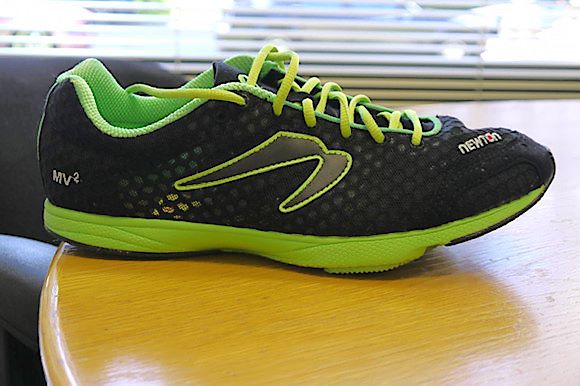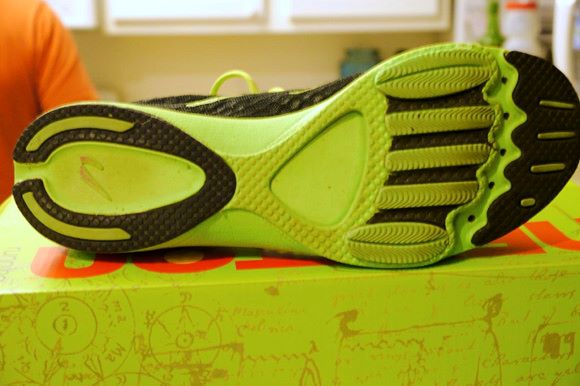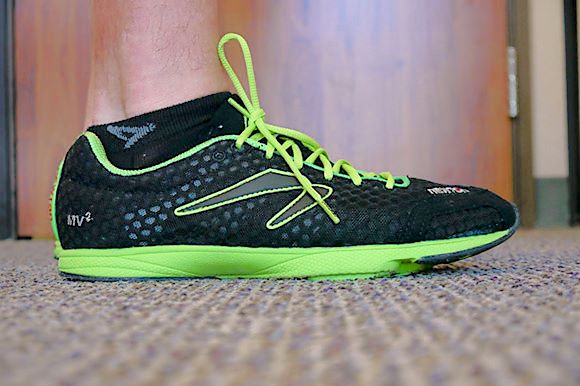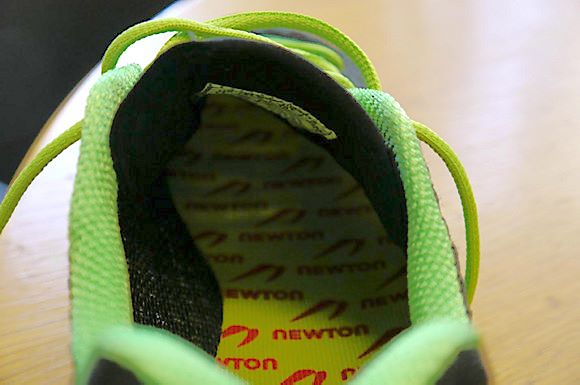Newton MV2
The Newton MV2 is a prime example of why the typical running store experience is faulty. To expect that someone could walk into a store wearing street clothes, pick an unknown pair of shoes off a wall, walk or run around the cramped aisles (or at best knock out a couple minutes on a treadmill) then select a key piece of equipment that will accompany them on 2, 3 or even 24 hour journeys is entirely unreasonable. Had I tried the Newton MV2 for only a few minutes, I would not have liked it.
The Newton MV2 was the first pair of shoes I was asked to test for Toe Salad. I was pretty excited about the opportunity. I was familiar with Newton and their Action-Reaction technology and had been curious to experience it for myself. However, being a big proponent of low, thin, flat and light shoes I had not found a pair of Newton's that felt quite minimal enough for my taste. When I read that the MV2 was positioned as Newton's version of a racing flat I thought it might be the one to finally try.
First Impressions
When I opened the box and pulled out the shoe two things stood out:
-
The shoe's construction is simple and mostly minimal. The upper is almost entirely a fabric mesh with the exception of a few accents and overlays in strategic locations to add structure and a small amount of support. Many of my favorite shoes have mostly mesh uppers as well, so this looked promising. The mesh on the Newton is slightly thicker than a woven material - it is more like a mesh wrapped open-cell foam.
 Side View of MV2 showing Clean Design, Simple Overlays
Side View of MV2 showing Clean Design, Simple Overlays -
The second aspect of the shoe that struck me was the lugs!
 Sole of shoe with 5 lug pattern visible on the bottom. The shoe is a little grimy because I was too excited and took them out for a run immediately upon arrival.
Sole of shoe with 5 lug pattern visible on the bottom. The shoe is a little grimy because I was too excited and took them out for a run immediately upon arrival.I described the shoe as mostly minimal because as soon as I flipped the shoe over the lugs - a hallmark of all Newton products - were immediately apparent. According to their website the lugs are strategically placed in the forefoot to improve biomechanical feedback and promote a forefoot strike. As someone who spends at least one run a week in huaraches, rubber lugs beneath my forefoot didn't quite fit my idea of minimal. This was a good time to remind myself the shoe is meant to promote natural running not necessarily minimalist running. Plus it's always good to keep an open mind.
Key Stats
- Website: http://www.newtonrunning.com/shoes/mens-shoes/men-racers/mv2
- Weight: 5.8 oz (size 9)
- Heel to Toe Drop: 0mm
(Note: The Newton MV2 also includes an insert that increases drop to 3mm to aide in transition)
Fit
When I put on the shoes on I noticed the shoe felt a little tight across the top of my foot; I was not shocked by this as the first thing I usually do with any shoe is open the laces as much as possible. I immediately loosened the MV2.
Once strapped in, I walked around the office and could definitely feel the lugs - it felt as if I rolled forward with every step. I was unconsciously forming my less than stellar first impression and should have reminded myself these are running shoes, not walking shoes. The shoe fits like many (most) racing flats and is a bit smaller in the toe box than I would prefer, but after sizing-up I have found the fit acceptable. I would however love a bigger toe box.
Styling
The shoe has a retro simplicity going. The mesh is either black or white with accents in either green or orange. The shoe stands out mostly because the lugs are pronounced and particularly visible from the side.

First Run
My first run in the shoes was a 6 mile tempo run. I managed to stay within 10 seconds of my target pace and felt like I was making no more than my typical effort; a good sign. The pads on the shoe were fairly noticeable during the run, especially on my slightly smaller left foot. This discrepancy made me wonder if a good fit/sizing was even more important with this shoe design.
The pads were noticeable during landing and without question the shoe promoted a mid/forefoot strike - it felt almost impossible to land any other way. The solid high density rubber beneath my forefoot did seem to help with keeping the 180 strikes per minute many of us pursue. Ground feel is definitely stifled by the shoe. The shoe does not feel like a minimalist shoe (and I do not really think it is trying to be one). I could feel different surfaces mostly by how I moved over them, or how they sounded, not the texture I can feel in other shoes. The shoe is also not as stable as others I wear, likely due to the increased height of the out/midsole and the lack of structure to the mesh upper.
Early Verdict: The shoe is interesting, but I am not sure how I feel about the pressure from the lugs or lack of groundfeel.
Treadmill Test
I'm not a treadmill runner. On my iPhone or Dailymile I list these runs as Dreadmill, but even so there are times when the best way to knock out a few miles is on the mechanical beast. With this in mind I also tested out the MV2's with some miles on the Dreadmill. To make the test more interesting I compared it against another minimalist shoe that was flat and offered little cushioning or support.
During the session I was pleased with the MV2's performance. Like on the road the forefoot bumpers provided a platform that made a forefoot strike easy to maintain. I found it easy to achieve my target paces for a given heart rate. The relatively stiff sole worked well with the support provided by the treadmill. I could still feel the bumpers but felt they made it easier than normal to land on my forefoot.
Rainy Run
I took the shoe out on a rainy day and traction felt good. There was no noticeable slip on wet asphalt, gravel, or a wooden bridge. I wondered how these shoes might fare as a trail shoe.
Sockless Test
I do not typically run without socks (see my sock review), but thought I would run at least a few miles in them to see how they felt. Overall I would say they felt good. The shoe doesn't have a made-for-sockless liner like many other shoes on the market, but no major seams or weird creases could be felt. I did feel the front of the shoe every now and then, and wished for a bigger toe box.

Speed Test
Since this shoe is marketed as a racing flat, I cut-loose on a run to see how the shoe feels at speed. The experience was positive, the stiff sole seems to allow for good transfer of force from ground to tendons and I was able to move at a fast pace without any strain in my calves or feet. I am sure these would be a good choice for a 5k or 10k.
Change of Opinion: After the first few runs in the MV2 I thought it was a decent shoe, but it's design was taking some getting used to. I am glad I did not give up on the shoe. The lugs definitely become less noticeable after multiple runs, however the positive reinforcement of a midfoot strike is still there. I have found myself reaching for the shoe for many of my tempo runs and even some speedwork days. The MV2 seems like a good choice for someone who wants to develop leg muscles before jumping right into a Huarache or other more minimalist footwear choices. I also think the MV2 would benefit someone that wanted a shoe that reinforced a mid/forefoot strike.
Final Thoughts
The Newton MV2 gets a positive review. I wish the shoe had a wider toe box and still am mixed about the lugs (almost feels like cheating) but the shoes perform well. I've now worn them for several types of runs and have enjoyed them all. The shoe lacks the structure needed for fast cuts, but on the straights typically encountered during road races/runs the shoe does great. If the shoes were a little bit cheaper I would definitely recommend that people new to minimalist running test them as I bet they would help the development of a natural running form. That said, the shoe is not much more expensive than a lot of shoes on the market, so if you are looking for a new shoe that helps emphasize natural running form, give the MV2 a test run (hopefully from a store that lets you run for more than a few minutes on a treadmill).
